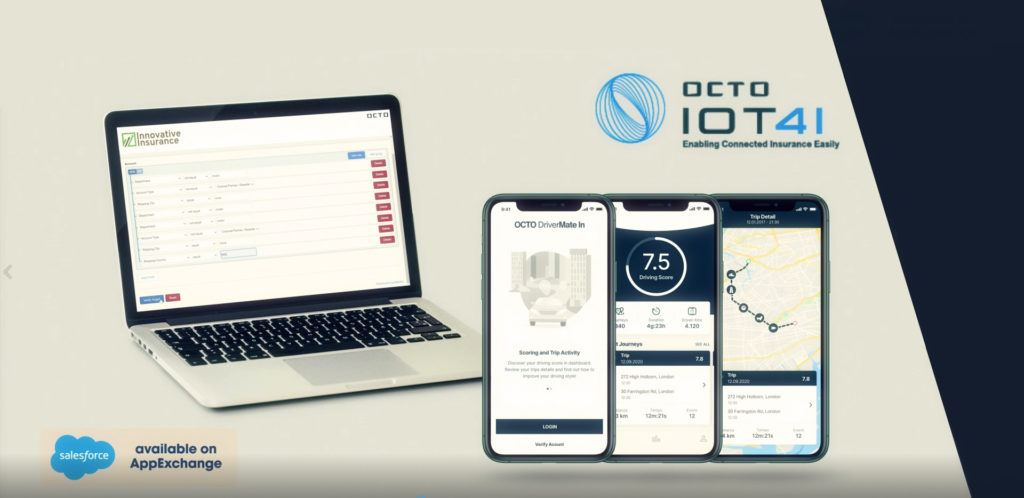
The last ‘I’ in OCTO IoT4I stands for ‘Insurance’. The app – now available via Salesforce Appexchange – might as well add an ‘R’. For it will revolutionise the insurance industry, benefiting both insurers and policy holders, while also improving traffic safety. How? We asked Massimo Gilardi and Francesco Ricci to explain.
“Insurers sit on top of mountains of information, much of it separated into silos – home insurance, auto insurance, property insurance, etcetera. Each silo is subject to different IT systems and business strategies. That makes it difficult for the insurers to cross-sell and up-sell products to their policy holders,” says Mr Gilardi, New Business Model Director at OCTO. “And that’s where OCTO IoT4I comes in.”
Cross-unit data
As the world’s largest telematics and data analytics provider to the auto insurance industry, OCTO knows a thing or two about the power of data. As the saying goes, ‘information wants to be free’. Translated into business terms, that becomes: “Data is cross-unit by definition,” Mr Gilardi says.
So, how does this help insurers? Put succinctly, OCTO IoT4I gives them access to the Driver Behaviour Score of their policy holders, based on which they can tailor various products to sell to them.
Online marketplace
That may still sound a bit abstract, so let’s start from the beginning: AppExchange, Salesforce’s online marketplace. In other words: an app store – but for corporates. “Salesforce is the world’s largest CRM platform, and it has grown rapidly thanks in large part to the trust and data privacy offered by Salesforce,” explains Mr Gilardi.
AppExchange offers third-party content including, since the beginning of November, OCTO’s IoT4I app. Insurance companies can download and run the app within their own data ecosystem.
They can use it to target policy holders with a campaign that offers them to download “OCTO DriverMate In” mobile app. This app turns their smartphone into a telematics device, helping them to analyse the details of their trips, plus score – and ultimately help to improve – their driver behaviour.
Extra engagement
OCTO grades the driver behaviour of each subject, and the insurers can use this information to tailor offers to them: a cheaper policy corresponding to their prudent driving behaviour, or incentives for improvement – to name just two examples.
“This way, OCTO IoT4I offers insurers extra ways to engage with their policy holders,” Mr Gilardi explains. “If you buy a home insurance policy, for instance, you have a low claim count, and the insurer typically only re-engages with the policy holder when it’s time to renew. With OCTO IoT4I, insurers keep their policy holders engaged with their clients on the basis of actual, useful content.”
Crucial part
And that’s the crucial part. Not only is telematics data used to break the insurance industry’s information siloes, that data can be used to modify quotes and/or tailor different offers. Insurers win, customers win. “It’s like insurers can use OCTO IoT4I to wake up their policy holders, especially no-motor line as if they were Sleeping Beauties,” laughs Mr Gilardi.
But the change goes much deeper, points out Francesco Ricci, Marketplace & New Business Models Analyst for OCTO. “The traditional attributes of a policy are quite static: the policy holder’s age, place of residence, job, etcetera. Now, via telematics, we add a whole range of additional information that is dynamic: when, how and how far vehicles are driven. IoT4I app allows to have clear the driver’s profile before the offer (policy or rent) and allows insurance (or rent) companies to personalize their offers.
Fine-tune
This can help fine-tune pay-as-you-drive policies, which no longer have to rely on declarations and estimations, but can use actual data. Policies can now also factor in such elements as driving times – do policy holders drive more during the day or night, weekdays or weekends? And of course, elemental driving behaviour can be brought into account: braking, accelerating, cornering…
“This is a much better way to identify risk than merely using traditional insurance data. This product solves the problem of every companies that need to qualify drivers before they sell the product itself (ex: renting and mobility); we’re entering an era of dynamic insurance policies, which can become an instrument for actively improving driving behaviour,” says Mr Ricci. “Via telematics, the degree of engagement between insurers and policy holders increases exponentially – up to several interactions per trip. Ultimately, engaging drivers will help improve road safety and will offer them the benefit of better-priced policies.”
Right moment
But helping insurers cross-sell and improve the quality of their policy portfolios is not all that OCTO IoT4I can do. Despite the final ‘I’, it can also be used by other customer groups – lease companies, for example, who want to present lease drivers with offers to acquire their vehicles after contract, based on driver behaviour monitored via IoT4I.
This is the right moment for a product like OCTO IoT4I to transform the market, Mr Gilardi thinks. “The pandemic has really pushed both the mobility sector and the insurance industry towards digitalisation as a way to optimise their processes. OCTO IoT4I offers a way to build a road to success in the ‘New Normal’ journey of today and tomorrow.”
OCTO IoT4Insurance is currently available on the AppExchange at OCTO IoT4Insurance.
More info:
https://www.octotelematics.com/octo-iot4insurance/